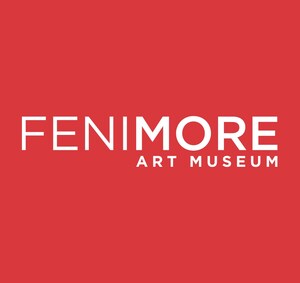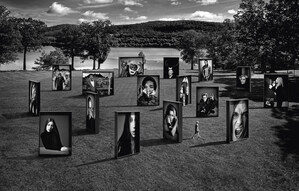Exhibition features more than 160 works and spans Escher's entire career.
COOPERSTOWN, N.Y., May 25, 2023 /PRNewswire/ -- Fenimore Art Museum in Cooperstown brings the imaginative design, consummate draftsmanship, and dreamy visions of the renowned M.C. Escher to Upstate New York with the exhibition M.C. Escher: Infinite Variations, on view May 27-September 4, 2023. This monumental show from the private collection of Paul and Belinda Firos of Athens, Greece features more than 160 works and spans Escher's entire career, from his early training in Italy and Spain to his final years in the Netherlands. Visitors will see nearly every iconic image he produced.
"This exhibition has attracted record crowds in cities across the country and Fenimore is pleased to share it with everyone in Upstate New York throughout the summer," said Dr. Paul S. D'Ambrosio, Fenimore Art Museum President and CEO. "Escher's work is complex yet easy to enjoy. Even if you are familiar with his work, you will certainly find plenty of new and inspiring details in this impressive collection."
Initially inspired by nature, Escher's later works became submerged in what he referred to as "mental imagery," a host of subjects influenced by Moorish architecture, mathematical equations, alchemy, and the concept of metamorphosis.
It was in 1937 that Escher stepped through what he called the "open gate of mathematics." He used his imagination and his technical expertise as a graphic artist to invent new visual constructions, challenging conventional perceptions of space, perspective, the "impossible," and the "infinite."
By the 1950s, Escher had developed a following among mathematicians and scientists who were intrigued by his tessellations and "impossible buildings." In the 1960s, his work was embraced as part of the pop-art and psychedelic movements. Escher's artwork was used, often without his permission, on everything from album covers to dorm room posters. His work has since become a symbolic bridge between science and art.
The exhibition displays some of Escher's most iconic works, including Day and Night, Ascending and Descending, and the fourteen-foot-long Metamorphosis. The collection also features numerous, seldom-displayed prints including the entire set of his mezzotints and one of the earliest, large format drawings done by the artist.
This exhibition was provided by PAN Art Connections.
M.C. Escher: Infinite Variations is sponsored in part by Robert and Esther Black Family Foundation, The Clark Foundation, Nellie and Robert Gipson, Joseph and Carol Mahon, Mr. Tom Morgan and Ms. Erna J. Morgan McReynolds, NYCM Insurance, Mr. and Mrs. Thomas O. Putnam, and Richland County Foundation.
Related Programming:
Virtual Symposium
M.C. Escher: Where Art, Math, and the Sciences Converge - STEAM-Based Virtual Symposium Tuesday, August 1 • 6:00-9:00 PM. Free. Pre-registration required.
About M.C. Escher
MAURITS CORNELIS (M.C.) ESCHER was born in Leeuwarden in the Netherlands in 1898. Mauk, as his family called him, always enjoyed a close bond with his engineer father and was drawn to art. He went to school in Arnhem and after studying architecture focused on graphic design. Professor Samuel Jessum de Mesquita, who recognized Escher's talent, was a strong influence on the young artist.
Escher visited Italy and Spain 1922. These auspicious trips would influence both his artwork and his personal life. He returned to Italy and met Swiss-born Jetta Umiker. The couple married in 1924 and settled in Rome where they had three sons. The Italian landscapes and architecture figured prominently in Escher's early work, but it was his visits to the Alhambra, a palace and fortress complex located in Granada, Andalusia, Spain, that profoundly influenced his use of pattern and tessellations. He was captivated by the floor and wall patterns of the Moors. Noting the predominance of abstract geometric designs to the exclusion of human and animal forms, Escher strove to create the same endless, interlocking patterns, but with recognizable figures.
In objection to the rise of fascism under Mussolini, the family left Italy in 1935, eventually settling in the Netherlands in 1941. Escher is most renowned for his work after 1937, when he walked through what he called "the open door of mathematics," and began to explore his visual concepts of duality, mirror images, multiple dimensions, relativities, infinity, and impossible constructions. He read several treatises on crystallography and the works of mathematician George Polya. He left it to those who were trained in the exact sciences, however, to explain his work in mathematical terms. Even as scientists, crystallographers, and mathematicians showed a great interest in his work, Escher said, "Although I am absolutely without training or knowledge in the exact sciences, I often seem to have more in common with mathematicians than with my fellow artists."
M.C. Escher worked, lectured, and published treatises on his artwork and its connection to science and mathematics into his 70s. His final work, Snakes, was created in 1969 and is on display in this exhibition. During his lifetime, Escher made 448 lithographs, woodcuts, and wood engravings, and more than 2,000 drawings and sketches.
In 1970 Escher moved to an artists' retirement home, complete with its own studio. He died in 1972 at the age of 74. With the 1979 publication of Douglas Hoftsadter's Pulitzer Prize-winning book, Gödel, Escher, Bach, the artist's reputation as a creative thinker was firmly established for future generations.
About Fenimore Art Museum
Fenimore Art Museum, located on the shores of Otsego Lake—James Fenimore Cooper's "Glimmerglass"—in historic Cooperstown, New York, features a wide-ranging collection of American art including folk art, important American 18th- and 19th-century landscape, genre, portrait paintings, photography, and the renowned Eugene and Clare Thaw Collection of American Indian Art. Changing exhibitions have featured well-known artists including Keith Haring, Ansel Adams, Andrew Wyeth, and many others. Summer hours: Open daily 10:00 a.m.–5:00 p.m. (May 27-October 9). Museum admission is free for ages 19 and under. Visit FenimoreArt.org.
About PAN Art Connections
PANART is a globally active company, founded in 2010 by a team of accomplished museum professionals who are deeply passionate about art and dedicated to elevating visitor experiences through world class exhibitions.
Images available by request.
Social Media:
Instagram: @Fenimoreartmuseum
Twitter: @fenimoreart
Facebook: Fenimore Art Museum
#FenimoreArtMuseum
#EscherAtFenimore
SOURCE Fenimore Art Museum

WANT YOUR COMPANY'S NEWS FEATURED ON PRNEWSWIRE.COM?
Newsrooms &
Influencers
Digital Media
Outlets
Journalists
Opted In




Share this article